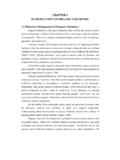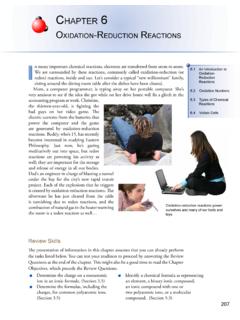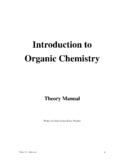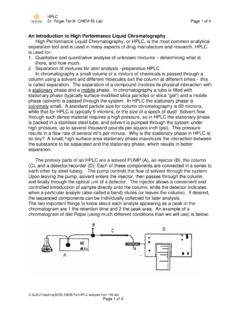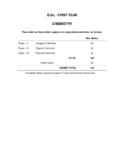Transcription of CHAPTER 18 MEDICINAL CHEMISTRY 18.1 Introduction
1 CHAPTER 18 MEDICINAL IntroductionThe treatment of pain and disease is one of the most important goals ofhumankind. Since ancient times people have been using potions, natural productsand even the dust of mummies for the treatment of health problems. The healingeffects of remedies were often ascribed to spirits and mythical entities, but someof the herbal preparations did possess curative properties. In the 1800's scientistsbegan to investigate potions to determine what chemicals were present that couldcause the observed , the early days of MEDICINAL CHEMISTRY began with the study ofnaturally occurring materials that were effective in treating human disorders. Thestudies were tedious and required much sample purification and structuredetermination at a time when instrumental methods of analysis were , screening methods for chemical efficacy against disease had to bedeveloped so that humans were not used as AntibioticsModern therapy by chemicals, chemotherapy, is attributed to Paul Ehrlich(Germany, Nobel Prize in 1908) who synthesized the first antibiotic, an arseniccompound patterned after an azo dye that he found to stain a microorganismselectively.
2 The compound first called compound 606 was introducedcommercially in 1910 as a treatment of syphilis under the name of (sylvarsan)336 Ch 18 MEDICINAL ChemistryMany compounds were investigated over the next 50 years as antibacterialagents. Some structures are very complex and necessitated the development ofnew synthetic organic reactions in order to prove their structures. An intenseeffort to develop MEDICINAL agents against malaria was required because manysoldiers were afflicted with the disease. Quinine, discovered active againstmalaria in 1990, was reasonably toxic, and other agents were (1946) was synthesized and found to be highly effective (C2H5)2,,,CH3quinineIsolated from cinchone bark.
3 ChloroquineCareful studies of the antibacterial compound known as Prontisil ( , Nobel Prize, 1939), a dye that strongly stains proteins, showed that itwas metabolized to sulfanilamide, a more effective antibiotic. Prontosil istherefore termed a prodrug as it is not the substance responsible for thebiological effect but it does produce the effective studies led to the investigation of compounds containing thesulfonamide function as potential antibiotics, and led to a number of veryeffective antibiotic agents. Many of these compounds are sulfanilamides thathave an organic group in place of one of the hydrogens of the proved to be a highly effective antibiotic. Antibiotics 337H2 NSO2 NHSN sulfathiazoleAs the search for better antibiotics continued, a revolutionary drug wasdeveloped by H.
4 W. Florey and E. Chain in 1938. Penicillin was produced bymicroorganisms of mold and was found to inhibit the growth of othermicroorganisms. Penicillin was so important in the treatment of bacterialinfections that many research groups from all over the world combined theirresearch efforts in the isolation, purification, testing and synthesis of penicillindrugs. The structurally related cephalosporin antibiotics were also discoveredduring this FPenicillin GPhCH2 Penicillin VPhCH2 NCOOHHHOSCH2 OAcONHNH3 OOC+cephalosporin C 1956broad spectrum antibioticThe search for antibiotics continued to be successful with the isolation andstructure determination of the complex antibiotics streptomycin and Ch 18 MEDICINAL ChemistryOOOOOHCHOCH3CH2 OHNHCH3 OHOHOO streptomycin1944 HONH2-C-NHHOHONH-C-NH2 NCH3)2 OHOONH2 OHOOHOHCH3OH1953 HOtetracycline Chloramphinacol, isolated in 1947, possesses a relatively simplestructure.
5 With its two chiral carbons, it has four stereoisomers. Studies at Parke,Davis and Co. showed that only the R, R stereoisomer is active againstmicroorganisms. This finding began the study of stereoisomers as of typhoid feverAntibiotic agents with large ring systems were also , a macrocyclic compound, is effective against penicillin resistantbacteria. Another large ring system that contains only amino acids is TyrocidineA, a component of gramicidin antibacterial agents. Some cyclic peptides are usedin the treatment of other diseases such as Hodgkin's disease. Antibiotics 339 OOOCH3 OHOCH3CH3 OCH3 OON(CH3)2CH3CH3CH3 OCH3 HOCH3erythromycinCH3CH21952 HOHOCH3 TyrGluAspPheOrnValPheProD-PheLeuTyrocidi ne A1939D-The search for new antibiotics continues with an emphasis on discovery ofdrugs that are effective against drug-resistant bacteria.
6 A -lactam class ofantibiotics called carbapenems show promise with broad spectrum antibioticproperties. A new experimental carbapenem is shown Carbapenem1999++ OpiatesOpiates belong to a class of compounds known as alkaloids that arenitrogen containing substances found in several plant species. The naturallyoccurring nitrogen compounds found in dried opium seeds are called opiates andare well-known for their strong analgesic effects and for their highly addictivenature. Opium extracts have been used for many years to treat pain, but only inthe early 1900's was the seed analyzed and found to contain over twentyalkaloids. Morphine accounts for about 10 % of the extract by weight. Scientists340 Ch 18 MEDICINAL Chemistrystudied morphine and similar compounds for many years until its structure wasdetermined by synthesis in 1954.
7 Two other pain-killing alkaloids with highlyaddictive properties are also found in opium, heroin and is perhaps the most abused substance in today's , R2= H MorphineR1, R2= Ac HeroinR1OR2OR1 = H, R2= CH3 CodeineMorphine, in MEDICINAL CHEMISTRY , represents a very important leadcompound for the derivation of new pain alleviating drugs. Morphine, and manyother naturally occurring biological substances, contains the well-recognized -phenethylamine structure outlined with heavy lines. This structural unit is alsofound in lysergic acid diethyl amide (LSD), another widely abused substancederived from an -phenethyl structural unitEt2 NLysergic Acid Diethyl AmideLSDM orphineThe many studies of morphine-like compounds have given someinteresting facts about the structural requirements for the drug's activity.
8 For Opiates 341example, the N-methyl group, the secondary alcohol, and the alkene functions areunnecessary for drug activity. Replacement of the N-methyl with N-allylproduces nalorphine that acts against the activity of morphine and serves as atreatment for overdoses of morphine, but it has hallucinogenic side of the ring system are also possible and produce someinteresting morphine-like drugs. Removal of the ether ring, along with thealcohol and alkene, produces after methylation, dextromethorphane a popularingredient in cough syrupRemoval of both the ether ring and the cyclohexenol ring, with addition ofa cyclopropyl function on the nitrogen give bremazocine that is 200 times moreactive than Ch 18 MEDICINAL ChemistryOHBremazocineC2H5CH3 NOHCH2CH31970 Further modification with removal of the ether ring, the cyclohexenol ringand the cyclopentane ring to leave a phenyl substituted piperidine ring producesthe drug that is about six times as active as removal of all the rings except phenyl produces the well-knownmethadone.
9 Methadone is used in the treatment of morphine addiction because itsside effects are less severe than that of morphine, but it is just as course, thousands of compounds related to the morphine structure havebeen prepared and many without activity, and no compound has been found tohalt the terrible addictive morphine properties. Used correctly, the morphine Opiates 343family is an important class of analgesics, and their study represents an importantcontribution to the understanding of MEDICINAL Methods of Drug DiscoveryThe discovery of new drugs is exemplified in the above sections onantibiotics and analgesics. The procedure is much more refined now than nearly ahundred years ago, but the steps in discovering new drugs or lead compounds todrugs are still Drug ScreeningPerhaps the largest effort of the pharmaceutical industry is the search fornew drugs.
10 Many compounds from many sources, both natural and synthetic, aretested for effectiveness against many types of medical problems. Screeningrequires many involved tests in both test tubes and in live subjects. Analysts needto be very astute in their observations in order not to miss a new drug or toimproperly evaluate an effective drug. Once a compound is found to be aneffective MEDICINAL agent, then it is the lead compound. New compounds aresynthesized in the laboratory in order to find perhaps a better medicine or onewith less toxicity. The process takes many years of intense examples of compounds found in natural sources have been seen asthe antibiotics or the analgesics. Scientists then follow up on the lead compoundsand attempt to synthesize better older drug, ephedrine, was discovered in 1924 from the herbs ofChinese medicine as a treatment for breathing problems such as chemists have modified the structure to provide a wide base ofbronchodilator Ch 18 MEDICINAL ChemistryTaxol, is a very complicated substance found in the California yew treebark.
